FAUNA PARAGUAY CHELICERATA: SCORPIONES
Twelve species of scorpions in two families have been documented as occurring in Paraguay (* species with photograph, total 4 species).
BOTHRIURIDAE
Sternum consists of two broad transverse bars and is several times broader than it is long. Total length 2.5-6cm. Colouration varies from yellow to black.On the cheliceral fixed finger the medial and basal teeth are fused into a bicusp. Movable finger with one or two subdistal teeth and a single basal tooth on the dorsal margin; the distal external tooth is smaller than the distal internal toothe and generally not apposable to it; the ventral margin is smooth. Coxapophyses do not possess anteriorly expanded lobes. The sternum is represented by a narrow transverse plate. There are no tibial spurs. Prolateral and retrolateral (exterior) pedal spurs are present. Except in Brachistosternus, the tarsi possess two rows of ventral spines. Brachistosternus inhabits sandy soils and possess bristlecombs on the tibiae and tarsi; the increased surface area afforded by these bristlecombs prevents the scorpion’s legs from sinking into the sand. The venom glands are thickwalled and folded; the venom is opalescent. The telson lacks a subaculear protuberance. The hemispermatophore is lamelliform. The capsular region is well developed and, in Brachistosternus, possesses spines . The distal lamina is characterized by the presence of a strong crest on the externolateral aspect. The paraxial organ lacks accessory glands. Ovariuterus forms a reticulate mesh of six cells. A single saclike diverticulum is suspended from the genital atrium in some species; lateral diverticula are lacking. Development is apoikogenic.
Characteristics of genus Bothriurus : Legs with both prolateral (pps) and retrolateral pedal spurs (rps) . Ventrodistal aspect of metasomal segment V with a ventral transverse carina forming a distinct arc (Fig. 3.15A); longitudinal carinae may be present as well; cheliceral movable finger with 1 subdistal tooth; male telson with conspicuous dorsal gland.
Bothriurus bonariensis
Bothriurus moojeni
Bothriurus guarani
Characteristics of genus Brachiosternus :Ventral aspect of pedipalp patella with 6 or fewer trichobothria; ventral aspect of chela manus with 10 or fewer trichobothria; total number of trichobothria on pedipalps ranging from 48 to 56; lateral eyes in 3 pairs: Tarsi with ventral setae, rather than spines (Fig. 3.15C); ventral aspect of cheliceral movable finger with 4 to 6 setae; hemispermatophore with spines in the capsular region
Brachiosternus ferrugineus
Characteristics of genus Timogenes : Legs with both prolateral (pps) and retrolateral pedal spurs (rps). 6 to 10 ventral trichobothria on pedipalp-chela manus. Male chela with semicircular depression on inner surface near origin of fixed finger
Timogenes dorbignyi
*Timogenes elegans
Designed by Paul Smith 2006. This website is copyrighted by law.
Material contained herewith may not be used without the prior written permission of FAUNA Paraguay.
Material on this page was provided by Paul Smith, Arne Lesterhuis and John Kochalka and is used with their permission.
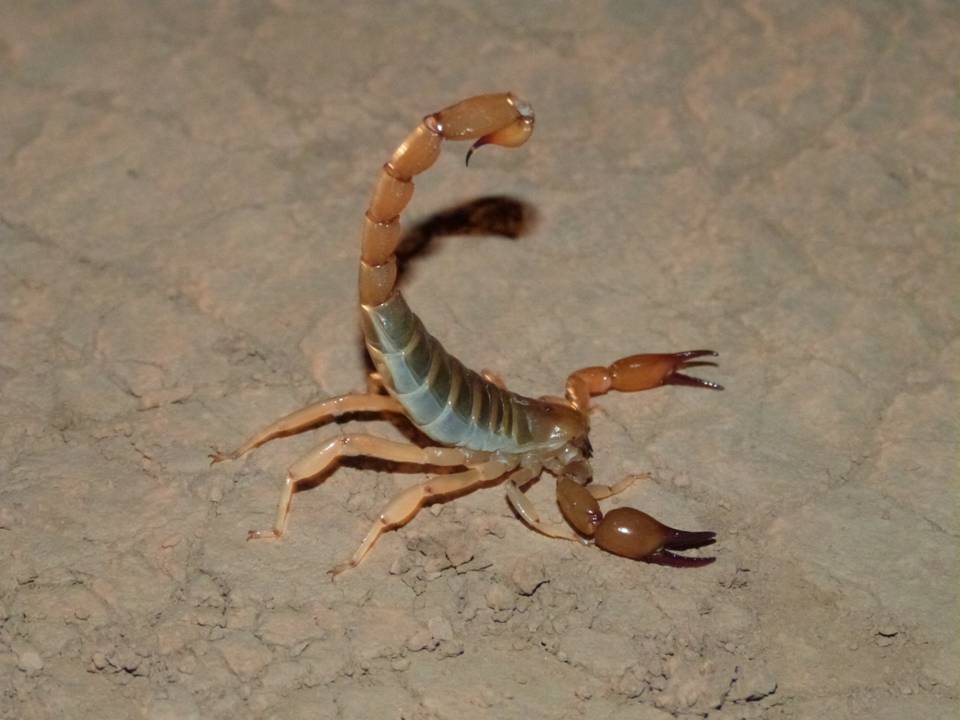
|
|
FIGURE 1a
|
|
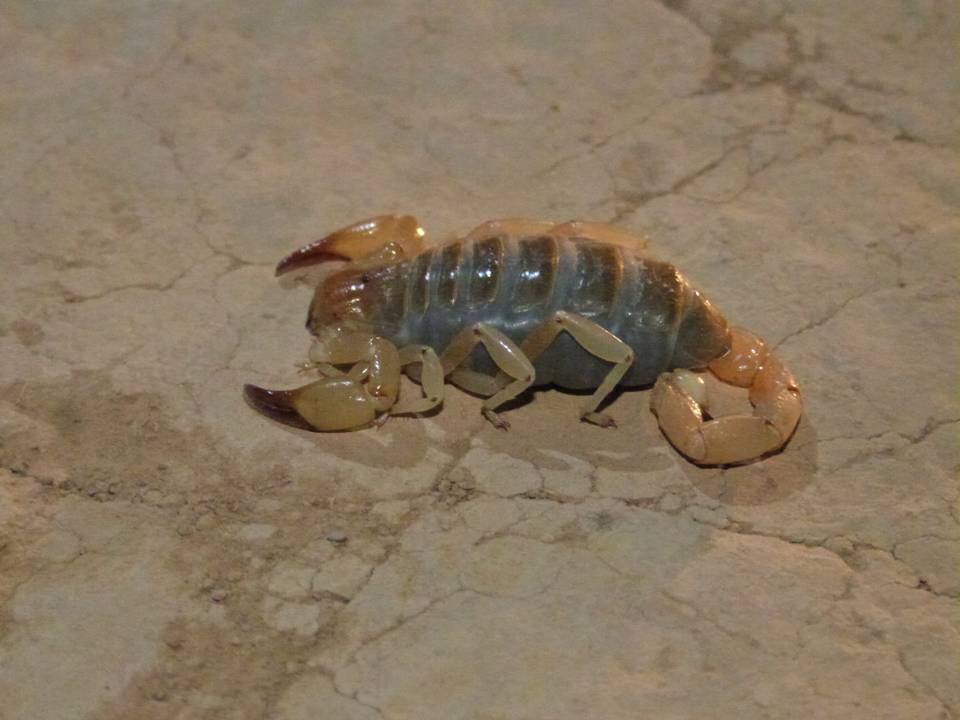
|
|
FIGURE 1b
|
|
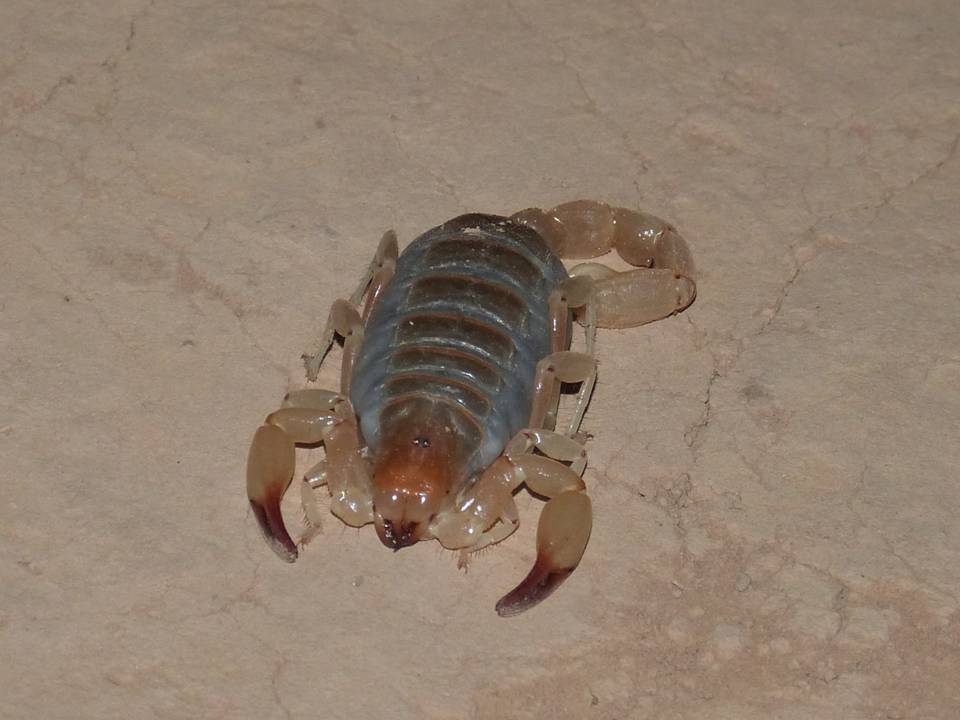
|
|
FIGURE 1c
|
|
Gallery 1 Bothriuridae
FIGURE 1a - Timogenes elegans (male threat), Tunakojai, Departamento Boquerón (Paul Smith September 2014).
FIGURE 1b - Timogenes elegans (female), Tunakojai, Departamento Boquerón (Paul Smith September 2014).
FIGURE 1c - Timogenes elegans (female), Tunakojai, Departamento Boquerón (Paul Smith September 2014).
BUTHIDAE
Sternum triangular. Total length 2-12cm. Much variation in colouration and length. The cheliceral fixed finger has the medial and basal teeth fused into a bicusp. The movable finger has a single subdistal tooth and two basal teeth on the external margin; the distal external tooth is larger than the distal internal tooth and generally is apposable to it (i.e., the two teeth form a fork); there are two teeth on the internal margin. The coxapophyses do not possess anteriorly expanded lobes. Although most buthids have a subtriangular sternum, all first-instar buthids possess a subpentagonal sternum. Tibial spurs are present on legs III and/or IV in Ananteris, absent in Tityus. Both prolateral and retrolateral pedal spurs are present. The venom glands are thin-walled and folded; the venom is opalescent. The telson usually bears a subaculear tubercle or tooth.The hemispermatophore is flagelliform. The trunk is long and slender, and four simple lobes arise at the truncal flexure. The ovariuterus forms a reticulate mesh of eight cells or two cells (in Tityus ). Diverticula absent. Development is apoikogenic.
Characteristics of genus Ananteris : Tibial spurs present on both legs III and IV or, if present only on leg IV, then the second metasomal segment is much wider than the other metasomal segments. Pectines without fulcra. 2-4cm long, colouration brown or reddish with spots on the body, legs and palps.
Ananteris balzani
Characteristics of genus Tityus : Legs III and IV lacking tibial spurs.Tergites I-IV with 1 distinct median longitudinal carina (a vestigial lateral pair, if present, may be found at the posterior tergal margin); trichobothrium d2 of pedipalp femur always present; telson with subaculear tubercle. Dentate margins of pedipalp-chela fingers composed of 12 to 17 oblique rows of granules; adults without supernumerary granules flanking these rows. Spiracles of book lungs large, elongate oval or slitlike; trichobothrium d5 of pedipalp femur distinctly basal to e1
Tityus bahiensis
*Tityus confluens
*Tityus mattogrossensis
Tityus paraguayensis
*Tityus trivittatus
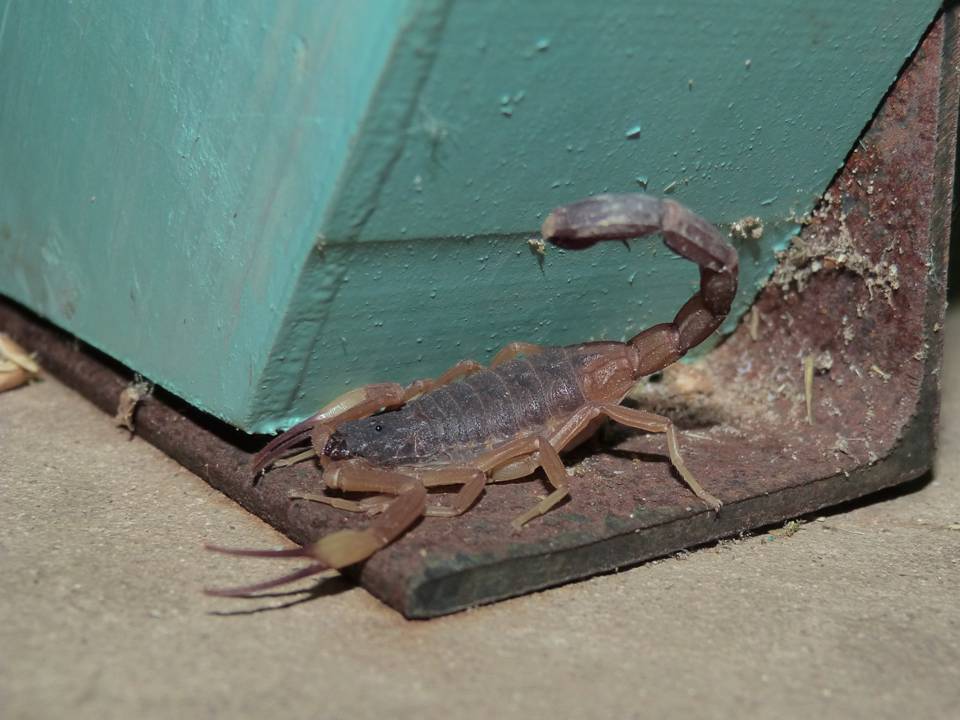
|
|
FIGURE 2a
|
|
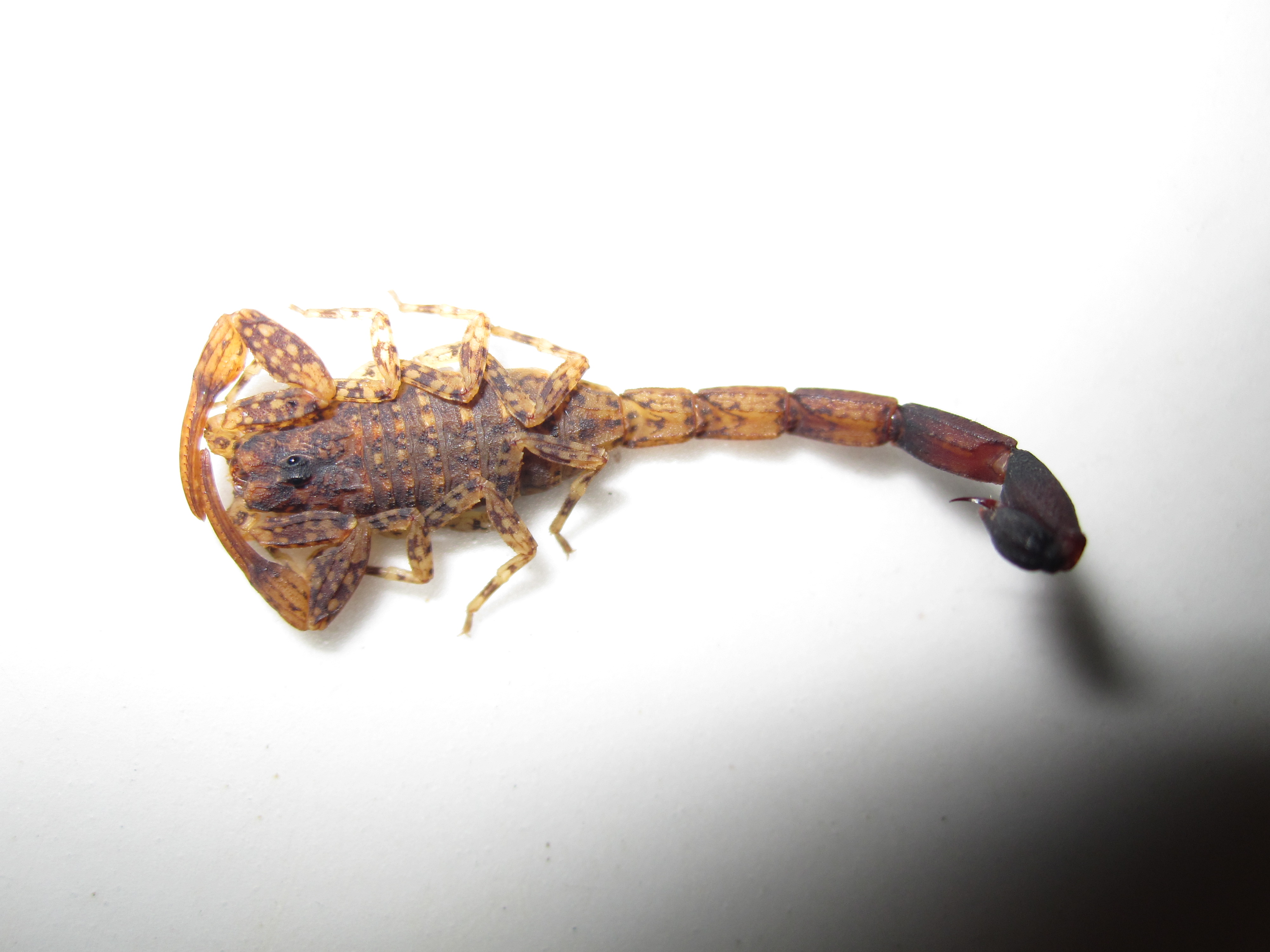
|
|
FIGURE 2b
|
|
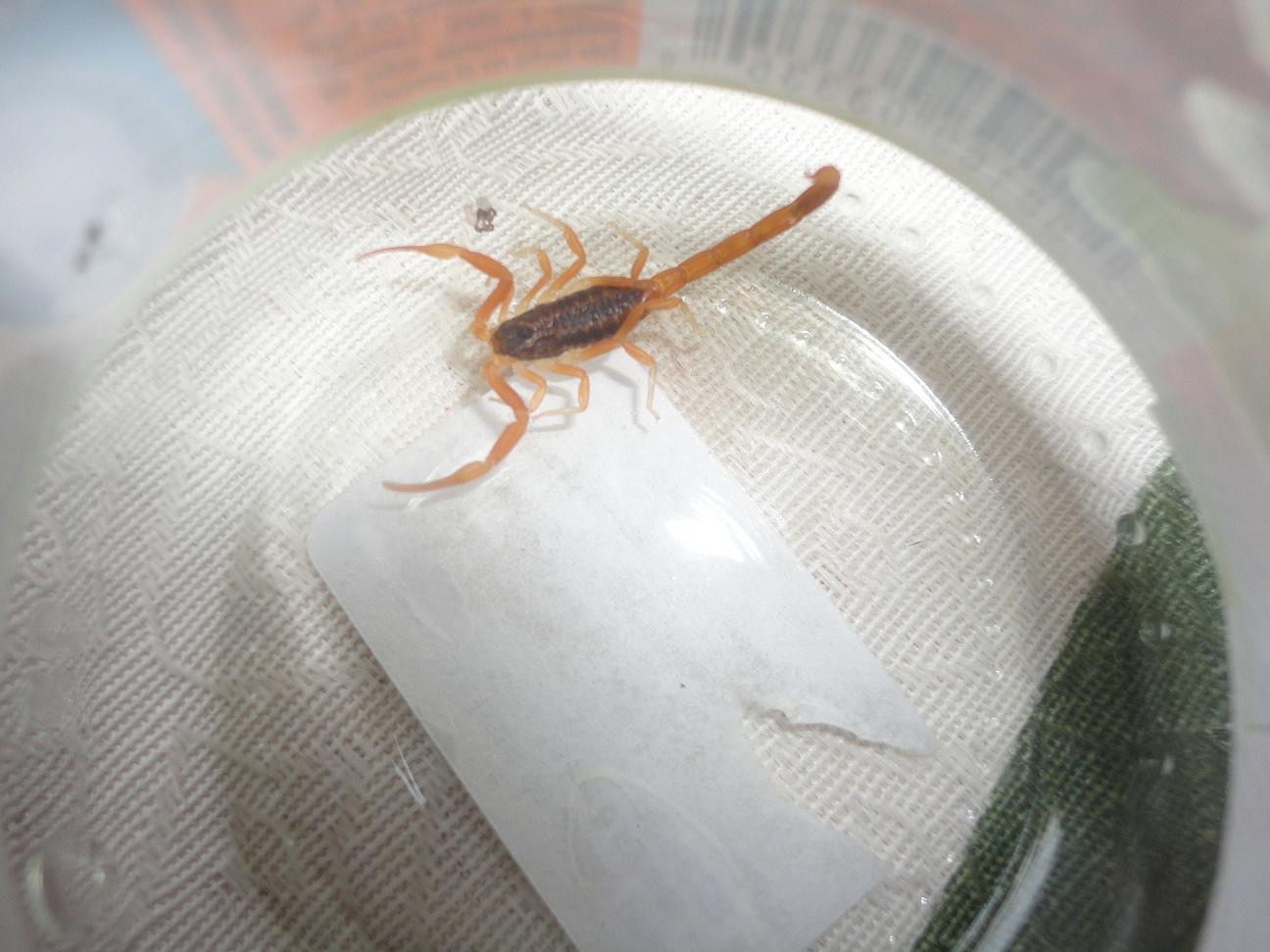
|
|
FIGURE 2c
|
|
Gallery 2 Buthidae
FIGURE 2a - Tityus confluens, Tunakojai, Departamento Boquerón (Paul Smith September 2014).
FIGURE 2b - Tityus matogrossensis unknown (John Kochalka undated).
FIGURE 2c - Tityus trivirgattus, Asunción, Departamento Central (Arne Lesterhuis September 2010).
REFERENCES
BORELLI A., 1899. Viaggo del Dott. A. Borelli nella Republica Argentina e nel Paraguay. XXIII. Scorpioni. Bolletino del Museo di Zoologia e Anatomia Comparata di Torino, 14 (336): 1-6.
CANESE A., 1966. Animales venenosos del Paraguay. Revista Paraguaya de Microbiologia, 1 (1): 56-72.
KOCHALKA J.A., TORRES D., GARCETE B. & AGUILAR C., 1996. Lista de Invertebrados de Paraguay pertenecientes a las colecciones del Museo Nacional de Historia Natural del Paraguay. Orden Scorpiones. pp88. In ‘’Colecciones de Flora y Fauna del Museo Nacional de Historia Natural del Paraguay’’, MNHNP, Martinez O.R. ed., 283pp.
LOURENÇO W.R.,1994. Synopsis de la faune des Scorpions du Paraguay. Revue Suisse de Zoologie, 101 (3): 677-684.
MAURY E.A., 1984. Dos nuevos Bothriurus de la Argentina y el Paraguay (scorpiones, Bothriuridae). Acta Zoologica Lilloana, 37 (2): 191-198.
MAURY E.A., 1984. Lista de los escorpiones conocidos del Paraguay ( Scorpiones, Buthidae, Bothriuridae). Neotropica, , 30 (84): 215-217.
POLIS G.A. ed., 1990. The Biology of Scorpions. Stanford Univ. Press., California: 587pp.
PURTSCHER H., BURGER M. & coll., 1983. Ofidismo y aracnidismo en el Paraguay. Revista Medica del Uruguay, 7 (1): 3-28.
ZIEGLER T. & LOURENÇO W.R., 2002. New scorpion records from the Gran Chaco of Paraguay (Chelicerata, Scorpiones). Entomologische Mitteilungen aus dem Zoologischen Museum Hamburg, 14 (166): 63-69.


